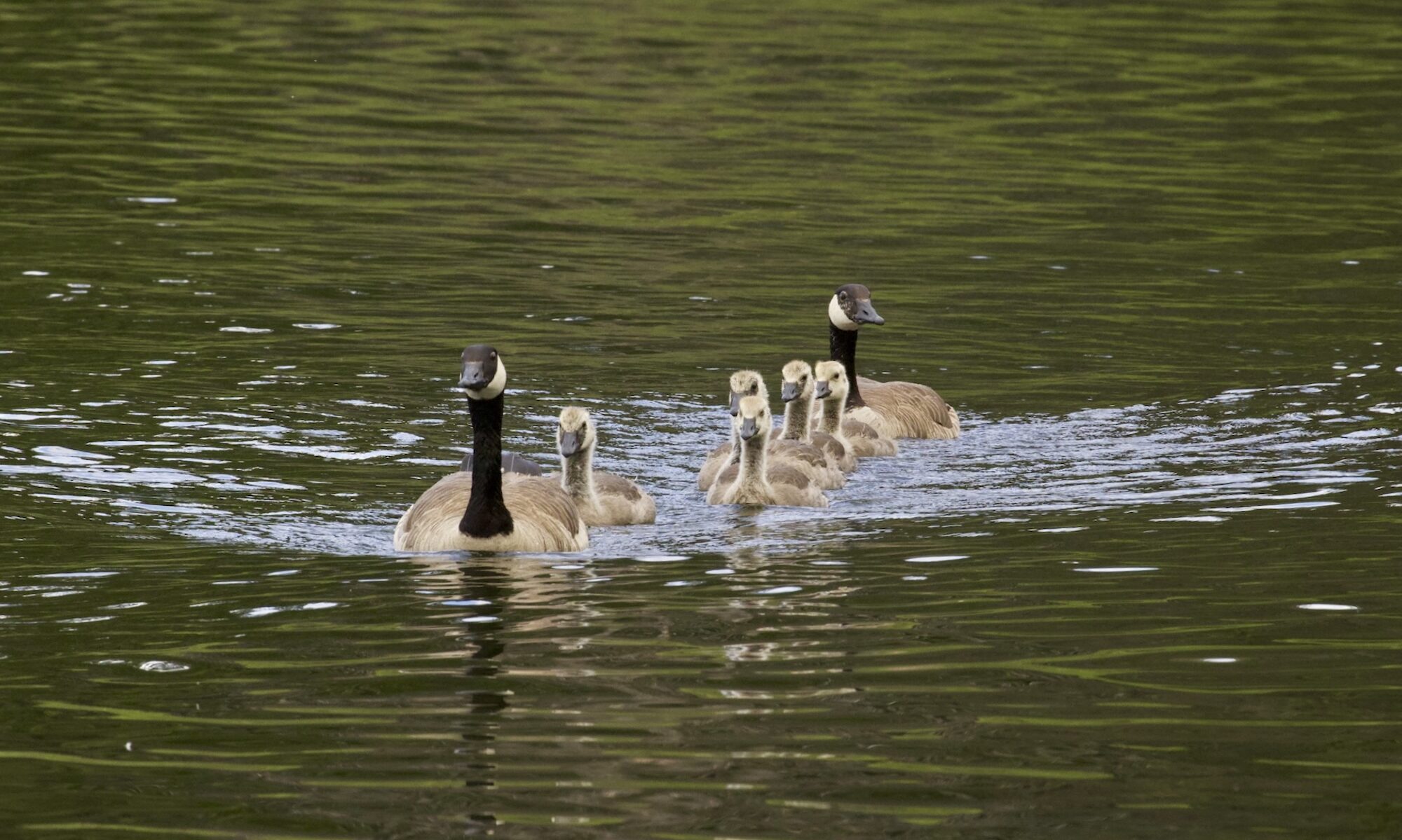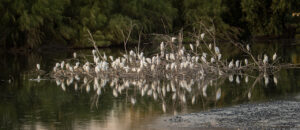
After settling into La Paz, we laid out several daily excursions that would expand both our familiarity with the area and our chances to see birds. For the latter, the most sensible resource is eBird. We learned that the water treatment facility was a great place to bird and we got there by passing through the Eco Parque Municipal De La Juventud De La Paz (AKA water treatment lagoons) warranted a visit (actually 2) and the Grand Plaza Hotel, La Paz another. The latter is the shell of a once fancy beachside resort that fell onto hard times. The security guard, Felix, was more than happy to show us the path to the back of the once resplendent gardens overlooking the bay. As we birded (and learned about his mother, his brother, where he’s from, and how boring security work is), Felix finally peeled off when his replacement showed up. So we enjoyed the sunset by ourselves on our return to the car, passing a number of dog owners using the place for you know what.
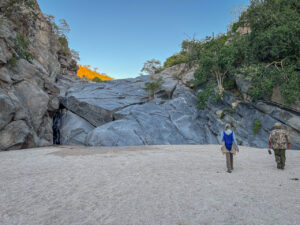
While birding the “Lagoons” the second day, we cozied up to a local photographer/birder and spent an hour or so with him that included looking for the elusive Belding’s Yellowthroat (unsuccessfully). It looks and behaves much like our “common” Yellowthroat, but is endemic to Baja, California, and features slightly different coloring. Meeting Martín turned out to be special because we arranged a follow-up to have him guide us to his family’s “rancho” in the hills miles out of town. Martín spoke no English, but we communicated in the language of birders international. We piled into his well-used Toyota Land Rover and plowed through the soft sands of the expansive arroyo that only a month earlier had been covered by water. Our goal was the Elf Owl, one of the smallest owls in the world and about the size of a sparrow. Shortly after dark, flashlights at the ready, we heard the bird call and followed the sound to a spot in a groove of Mesquite trees. With lights doused, our eyes adjusted to the bright starlight—just enough to see our target bird arrive silently right over my head. It disappeared deep into some foliage and Martín quickly found it with his lamp where it posed for a few seconds before splitting just as quickly as it had arrived. Although the sighting was brief, it was a high-five moment and equally as wonderful as the freshly made goat cheese he’d picked up from his cousin on our way into the canyon. Life bird #3.
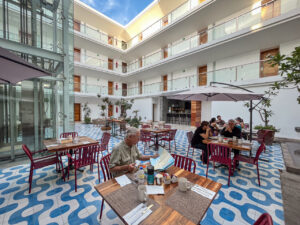
La Paz lies on the eastern shore of the Baja peninsula is situated at the southern-most stretch of an expansive bay. Our hotel (El Catedral) is situated directly across from the site of the original mission. In 1535, the Spaniard, Hernan Cortez charted the bay and called it Holy Cross Harbor. 150 years later, (1683), another explorer, the Jesuit Fr. Kino, “rediscovered” the port and named it Our Lady of Peace only to have it abandoned for another 50 years. Finally, in 1720, Fr. Jaime Bravo, another Jesuit, founded the current (and permanent) Mission of La Paz. The local market, Mercado Bravo, is named for him and is full of yummy local delicacies that we made note of.
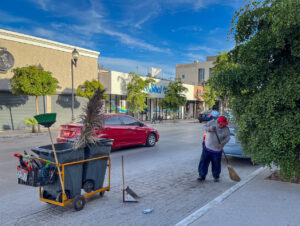
Separating the calm water of the bay from the town is a wide concrete promenade (the Malacon) and we found it a delightful way to stretch our legs and look for shorebirds. A month earlier, that terrible storm to the south didn’t hit La Paz with the same force as Acapulco, but the marina took quite a beating and apparently 40 vessels sank in its rage. We spotted several wrecks in both shallow and deep water as evidence of the storm’s velocity. Adjacent to the Malacon is a clearly defined bike path and adjacent to THAT is a two-lane boulevard that separates the walkers & cyclists from the lines of open-fronted restaurants. A perfect (or not) day to enjoy the Malacon is on Sunday, family day,, where thousands of friendly walkers, skate boarders, cyclists mirror the bumper-to-bumper traffic, boom boxes bellowing, and all for the apparent amusement of the crowds thronging to street-side restaurants for their special tacos, drinks, and whatevers. Outdoor stalls sell everything from trinkets and souvenirs to beautiful hand-worked jewelry by local artisans. It can truly be said that La Paz retains the look and feel of a well-loved Mexican city, certainly influenced by the tourist trade but holding onto its own special character. From our hotel, we walk a few freshly-swept (by hand!) blocks to Tres Amigos, for a morning French pastry (at least Sooney does and I accompany her), eat evening meals, and then swing around the corner for our daily Paleta.
The tide-impacted water of the Marina is generally calm, and the shoreline along the bay extends north for a dozen miles or so. One day we pointed our car out-of-town and drove to Playa El Tecolote, the launching point to the marine paradise of Isla Espiritu Santo. We chatted with a Canadian couple who were guiding a group of RVer’s (Baja Amigos RV Caravan Tours) and were gracious in sharing all the hotspots of our next destination, Loreto and day trips farther up the coast to Muleġe. En-route to the point, we passed the entrance to Playa Balandra with the intent of returned the following day.
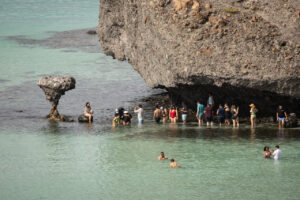
Playa Balandra is particularly unique as it’s a designated Mangrove Preserve and locals strictly enforce a limit of vehicles into the smallish parking area each morning and then, at noon, the beach is completely vacated and the afternoon allotment is permitted in. No venders in sight, we followed the one hiking trail to a bluff overlooking the entire bay. From atop, we spotted the infamous “mushroom rock” and 20 or so bathers lining up for a photo op. Allegedly, the top of the mushroom tumbled in a storm and those same locals devised a way to resurrect the monument for future generations. Good fun, a terrific destination for sunbathers, and the most sensibly-managed recreation destination we’ve seen for quite some time.
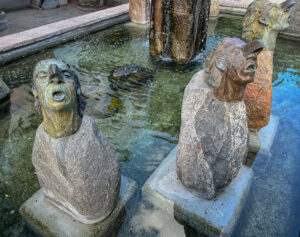
Our time spent in La Paz has been filled with several interesting surprises, and not all are associated with eating. When we checked into our hotel, a promoter had just placed flyers announcing a touring exhibition of “Frieda’s Garden” that celebrates not so much her art but her love of nature and the integration of flowers, animals, birds, and insects into her paintings. Other surprising places are interesting parks (e.g. Parque de Piedras & Parajos) that are walled public spaces with cozy locations to visit that feature beautiful sculptures, fountains, murals (and poetry) on the walls and, in one, large chess pieces that are are maneuvered on a 10′ square “board.” These areas are closed at night and monitored by security. Lovely places to consume takeout and just hang out.

A visit to Mercado Brava was sadly more of a reconnoissance than a mission since we happened onto it at the wrong time. The market is all about food—fruits, meats, and many stalls and mini cantinas featuring quick bites at no-frills counters. One vender in particular featured thick masa tortillas, grilled to perfection and then opened as one would a pita. The chef then spooned in ingredients from a lengthy menu posted on the wall and served them up fresh off the grill. It was one of those places you say we’ll dine on our next trip. Will there actually BE a next trip here? Quién sabe. We settled on a couple bananas and an orange and recommend that visitors go there on an empty stomach. We later followed up a recommendation from our bird guide, Martín, and enjoyed Los Magueyes, a reasonable walk from the Plaza and featuring one of the best Chile Relleños Sooney has had (and she’s an expert). I paired mine with an enchilada with green sauce and it was superb. The portions were sensibly-sized so that made things even better.
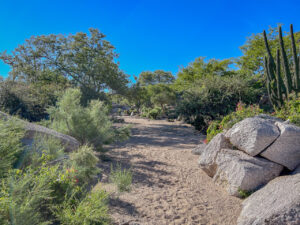
Our days were winding down in La Paz, so we reached out to the hotel staff for inside information about where we could walk in nature. With eBird hotspots as a resource, a day-long trip to the southeast was planned that included a couple hours birding in the Arroyo Los Encinitos. It’s on the road to the popular kiteboarding area of La Ventana, and accessible via a snarky dirt road to Pueblo de Tamales. Our destination was indeed that—an arroyo. A moist, sandy canyon bottom featuring shady Mesquite and Oak trees, the prominent song was that of the Ash-throated Flycatcher accompanying us as we walked among scavenging domestic pigs and goats. Now and then, a rancher would pass, greeting us and not particularly surprised by our binoculars and my long lens. On either hillside were ranchos, all connected by 2″ black plastic pipes to fresh water wells in the arroyo. Flowering plants and shrubs were everywhere, some domesticated and most wild. It was a magnificent location and at one location a stream trickled out of the granite hillside and fed a pool peppered with frogs & pollywogs. We loved the place, and our bird sightings clearly justified it as an eBird Hotspot. The peacefulness of the arroyo is captured in this short video.
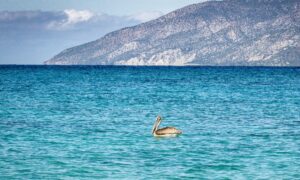
The gorgeous morning hues eventually passed as bright sunlight filled the arroyo. We resumed our journey for a refreshment stop at Bahia Los Muertos where we grabbed a cold beverage and watched a Magnificent Frigatebird diving stealthily close to local net fishermen. What a thrill it was seeing those huge, truly magnificent birds up close. Still on our itinerary was what our hotel’s receptionist referred to as her favorite beach, Punta Arena. We had no trouble locating the route, and after a couple miles on a sandy road we parked at a pristine white-sand beach lapped with turquoise water just beckoning for me to jump in (so I did). Just us, a Brown Pelican, and a few campers minding their own business down the beach. With no shade whatsoever and our beach thing done, we proceeded to lunch. (We later commented we’d not eaten in this many restaurants in years!). So, more desert driving, following signs to La Ventana and then Wham! Instant tourist beach town with robust construction projects in either direction around the bay.
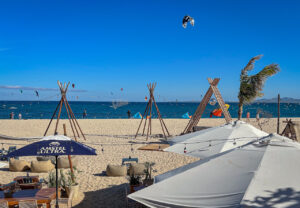
We asked a gringo if she could recommend a shady place to eat and enjoy the scene, and followed her directions by driving all the way through town to a large, colorful plastic ice cream cone where we were told to turn right and park. La Tuna was perfect—we had iced, freshly-squeezed lemonade paired with fabulous smoked tuna tacos and watched hundreds of kiters riding every type of wind craft imaginable. La Ventana introduced us to an ex-pat community that leaves a vehicle in Baja and flys down for fun in the sun (and wind). The complete opposite from the barren, calm tranquility where we’d been swimming only an hour earlier in Punta Arena de la Ventana, the location of a lighthouse on the southeastern point of the La Paz Peninsula.
A gallery of photos supporting this Travel Journal may be viewed at nickviani.com/birdingbaja23. As usual, wildlife-specific images are housed at sobirds.us. Finally, here’s a LINK to the next episode from this series, Birding Baja. Enjoy.
